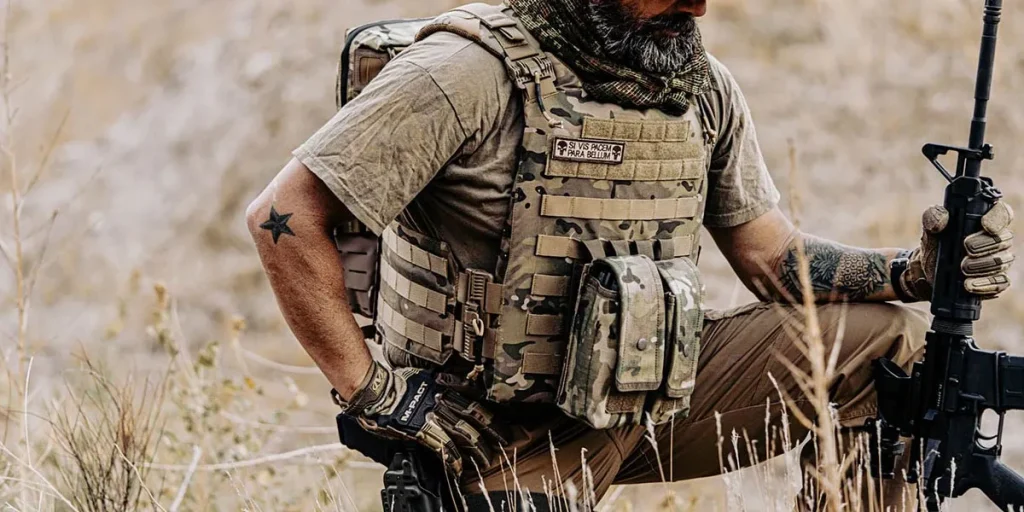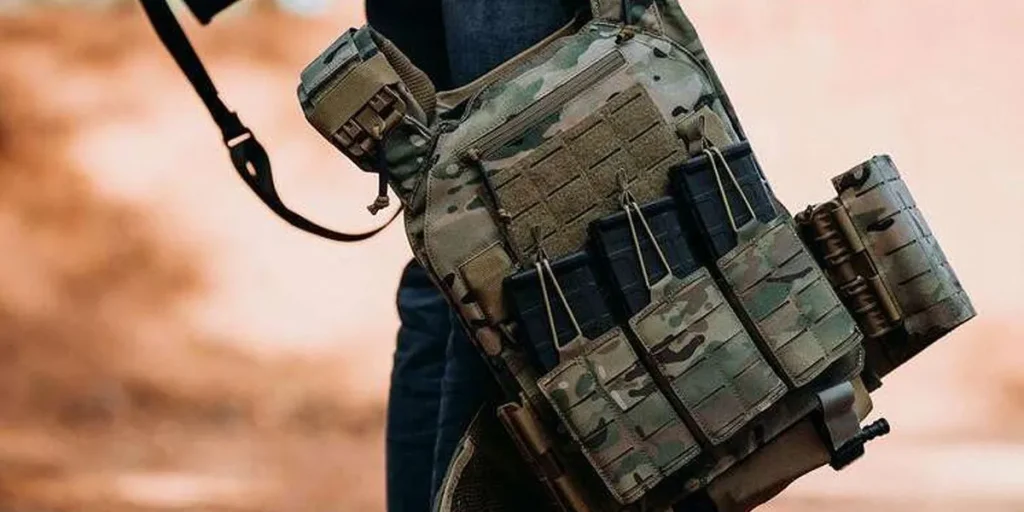A plate carrier without armor plates typically weighs between 1.5 to 3.5 pounds. The exact weight depends on the materials and size.
For those seeking protection and performance in high-risk environments, a plate carrier is an essential piece of tactical gear.
By distributing weight effectively, it allows for the swift addition of ballistic plates, enhancing defense capabilities while maintaining agility.
Military personnel, law enforcement officers, and shooting enthusiasts often utilize plate carriers to escalate their protective measures.
Each configuration is built for a balance of mobility and protection, yet the base weight is crucial for operational comfort and endurance.
Plate carriers come in a variety of styles, whether for concealed duty use or more robust external configurations, and the empty weight is just the starting point before adding plates and MOLLE-compatible accessories.
Anatomy Of A Plate Carrier
Understanding the Anatomy of a Plate Carrier is key. Plate carriers are tactical gear. They hold armor plates.
Soldiers and law enforcers use them. They protect from bullets. Weight varies depending on the model.
Materials And Construction
Plate carriers must be tough yet light. They use fabrics like Cordura and nylon. These materials ensure durability.
They resist tears and abrasions. Mesh linings offer breathability. Stitching must be robust. This keeps the carrier intact.
Common Features And Attachments
Plate carriers come with many features:
- MOLLE webbing – for additional pouches.
- Velcro patches – for identification.
- Quick-release buckles – for easy removal.
- Cummerbunds – for a snug fit.
- Hydration sleeves – for water bladders.
Each feature adds to the carrier’s weight. It’s vital to find a balance. The carrier should meet needs but not be too heavy.
The Bare Basics

Understanding the weight of a plate carrier starts with the basics. A plate carrier is a tactical vest. It holds plates to protect people.
Soldiers and police officers use them a lot. Knowing the weight is key for comfort and endurance. Let’s dive into the empty carrier weight and standard plate weights.
Empty Carrier Weight
An empty plate carrier might seem light. But, the materials matter. They can vary in weight. A standard empty carrier typically weighs between 1 to 3 pounds.
This does not include any plates or extra gear. Here’s a quick look at average weights:
- Nylon carriers: Usually the lightest, around 1 to 2 pounds.
- Canvas carriers: A bit heavier, roughly 2 to 3 pounds.
Standard Plate Weights
The plates inside the carrier add the most weight. They come in different materials. Materials affect the weight. Let’s compare standard plates:
| Plate Type | Weight (per plate) |
|---|---|
| Steel Plates | 8-10 pounds |
| Ceramic Plates | 5-8 pounds |
| UHMWPE Plates | 3-5 pounds |
Remember, these weights are per plate. Carriers often use them in pairs. So, you need to double the weights for a complete set-up.
Variations In Plate Carriers
Plate carriers come in different shapes, sizes, and weights. The weight of a plate carrier depends on several factors. These include material, design, and additional features.
Some plate carriers are for tactical operations. Others are for concealed use. Each serves a unique purpose. Let’s dive into the two main design variations.
Tactical Vs. Concealed Designs
Tactical plate carriers are for armed forces and law enforcement. These carriers are robust.
They often integrate additional gear like magazines and water. Tactical plate carriers are typically heavier. They can handle harsh conditions.
Concealed carriers are more discreet. They fit under clothing. These carriers are lighter. They allow for stealth and mobility. Users can go about their day without drawing attention.
Customizable Plate Options
Customization is key in plate carriers. Users can alter their carriers to match their needs. Here’s how:
- Plate materials vary from steel to ceramic to polyethylene.
- Steel plates are the heaviest. Ceramic plates offer a balance. Polyethylene plates are ultra-light.
- Additional gear changes the overall weight:
- Magazine pouches
- Hydration packs
- Extra padding
- Weight can be added or removed as needed.
Users can tailor their plate carriers for comfort, protection, and mission specifics. This ensures optimal performance in the field or for daily wear.
Additional Gear And Its Impact

The weight of a plate carrier is only the beginning. When fully kitted, additional gear significantly impacts the overall mass one carries.
Think of a plate carrier like a canvas, ready to be outfitted with the tools of the trade.
Yet, each item adds ounces or pounds, transforming the load from manageable to challenging. Let’s break down this additional gear.
Magazines And Pouches
Outfitting your plate carrier with magazines and pouches increases weight. Magazines, crucial for firearm support, add a few ounces each.
Fully loaded, a standard magazine might weigh about a pound. Factor in multiple magazines, and the weight adds up. Here’s a quick rundown:
- Magazine (empty): 4-5 ounces
- Magazine (loaded): 1-1.5 pounds
- Standard pouch: 3-4 ounces
Considering several magazines for readiness, your plate carrier’s weight could increase by 10 pounds or more.
Hydration Packs And Other Essentials
Hydration is key in the field. A hydration pack is not just another add-on; it’s a necessity.
A typical hydration bladder might hold up to 3 liters, equating to about 6.6 pounds of water weight. Essentials also include:
| Item | Weight |
|---|---|
| Hydration pack (3L of water) | ~6.6 pounds |
| First-aid kit | 1-2 pounds |
| Multi-tool | 0.5 pounds |
These items are vital for survival, and when water depletes, the weight does too. But start fully stocked, and the impact on your overall load is clear.
Gear up smartly, balancing necessity with the burden.
Real-world Loadouts
Understanding the weight of plate carriers in action is crucial. Professionals customize their gear for maximum efficiency.
In this post, we explore typical setups for military personnel and law enforcement officers. Watch how each loadout strikes a balance between protection and agility.
Military Loadout Examples
Soldiers gear up for a variety of missions, each requiring distinct equipment. Below are common military kits:
- Standard Infantry: Basic plate carrier with front, back plates, and side plates.
- Special Forces: Advanced carrier systems with pouches for radios, ammunition, and hydration packs.
- Patrol Units: Lighter carriers for mobility over extended periods.
Weights can vary:
| Component | Weight (lbs) |
|---|---|
| Plate Carrier | 3-5 |
| Plates (Each) | 5-8 |
| Additional Gear | 10-30 |
| Total: | 18-43 |
Gear choices dictate mission success.
Law Enforcement And First Responder Kits
Officers and first responders prioritize rapid response. Their kits reflect this:
- Active Shooter Response: Heavy plates for ballistic protection against rifle rounds.
- Riot Control: Lighter gear with added protection for non-lethal encounters.
- Day-to-Day Patrol: Concealable vests for unexpected threats, favoring mobility.
Typical weights are as follows:
| Kit | Weight (lbs) |
|---|---|
| Basic Vest | 2-4 |
| Heavy Plates | 8-10 |
| Full Tactical Kit | 20-30 |
Each kit is a balancing act of needs and duties.
FAQs About the Weight of a Plate Carrier
What Is The Average Weight Of A Plate Carrier?
Plate carriers typically weigh between 1. 5 and 3. 5 pounds without armor plates.
The weight varies based on the design, material, and size.
Can Plate Carrier Weight Affect Mobility?
Yes, plate carrier weight can affect mobility, especially when loaded with armor plates.
A heavier setup may impede quick movements and increase fatigue.
How Much Do Plates Add To Carrier Weight?
Armor plates can add significant weight, ranging from 4 to 10 pounds per plate, depending on the material and level of protection they offer.
Are There Lightweight Plate Carrier Options?
Yes, there are lightweight plate carrier options made of high-tech materials that reduce weight without compromising durability or protection.
Conclusion
Understanding the weight of a plate carrier is crucial for preparedness and comfort. Empty carriers can start at a mere 1. 5 pounds, whereas fully equipped ones may exceed 20 pounds.
Remember to factor in the type of plates and additional gear when calculating the total weight.
Always prioritize a balance between protection and agility to suit your needs. Choose wisely for optimal performance.
